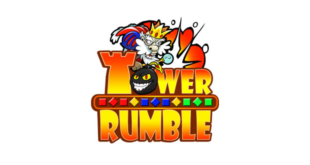When I first saw Chasm Jump, it looked to me like a superhard platformer in the style of Super Meat Boy. It advertised itself as a “one tap” jumping game, yet appeared to feature many dangerous-looking hazards which made me curious how it played. That curiosity led me through one solid run, and several crippled and pointless subsequent attempts before I recognized this game for what it is; an attempted money pit, and not super well-designed to boot.
 In Chasm Jump, you move through one screen of hazards at a time by tapping a single time. This causes your avatar to streak horizontally across the screen, and if he arrives at the other end untouched you move on to the next screen. The hazards become increasingly more dangerous as the game goes on, albeit unevenly. In my first and only modestly successful run, I encountered a few pockets of quite difficult levels early on followed by a streak of easy ones, and this pattern continued with seemingly little rhyme or reason throughout my run.
In Chasm Jump, you move through one screen of hazards at a time by tapping a single time. This causes your avatar to streak horizontally across the screen, and if he arrives at the other end untouched you move on to the next screen. The hazards become increasingly more dangerous as the game goes on, albeit unevenly. In my first and only modestly successful run, I encountered a few pockets of quite difficult levels early on followed by a streak of easy ones, and this pattern continued with seemingly little rhyme or reason throughout my run.
One of the most common hazard types I encountered dispensed deadly clumps of cubes at me, and these rooms were all across the board in terms of difficulty. Some could be passed trivially simply by tapping to cross the room before the clump-throwers started clump-throwing, and others would disperse the cubes so densely and so randomly that actually making it across the room became a crapshoot and waste of checkpoints instead of a skill-based endeavour.
 Oh, and did I mention? I only had one solid run because the game gives you twenty checkpoint uses to begin with, allowing you to return to the beginning of your last level. However it never replenishes these checkpoints unless you buy twenty more with real money. I am ranked #13 on the leaderboards simply because, I’m sure, very few players saw the point of spending over a dollar on twenty more checkpoints to burn. And it’s essentially the only way to keep enjoying the game after those first twenty are gone, due to the unpredictable nature of some hazards.
Oh, and did I mention? I only had one solid run because the game gives you twenty checkpoint uses to begin with, allowing you to return to the beginning of your last level. However it never replenishes these checkpoints unless you buy twenty more with real money. I am ranked #13 on the leaderboards simply because, I’m sure, very few players saw the point of spending over a dollar on twenty more checkpoints to burn. And it’s essentially the only way to keep enjoying the game after those first twenty are gone, due to the unpredictable nature of some hazards.
Had Chasmp Jump offered even progression, more renewable checkpoints, and a consistently fair and skill-based difficulty curve it is extremely likely that I would be praising the game in this review instead. The idea of a one-tap hardcore hazard-avoider on your phone is a good one, but in its current state, not only does it execute poorly on keeping the game tight, but it punishes the player for it by allowing them to waste all their checkpoints on inconsistent hazards with no recourse other than to buy more.





